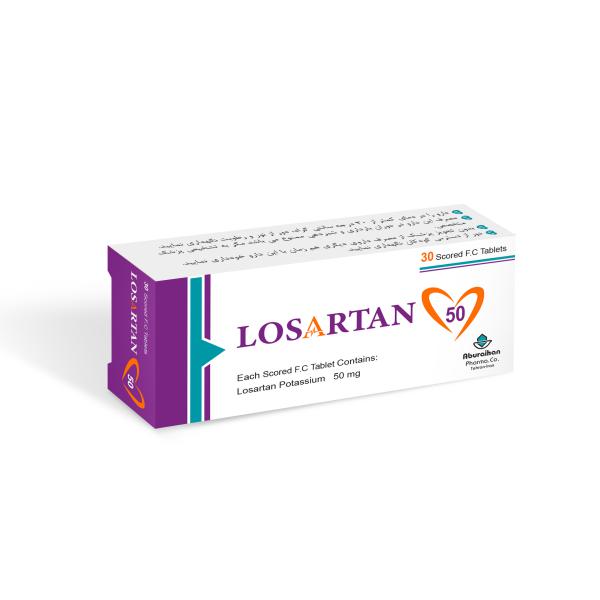Cardiosan®
Losartan
tablet
Hypertension, chronic: Management of hypertension in adults and children ≥6 years of age.
Proteinuric chronic kidney disease, diabetic: Treatment of diabetic nephropathy with an elevated serum creatinine and proteinuria (urinary albumin to creatinine ratio ≥300 mg/g) in patients with type 2 diabetes and a history of hypertension.
Mechanism of Action:
As a selective and competitive, nonpeptide angiotensin II receptor antagonist, losartan blocks the vasoconstrictor and aldosterone-secreting effects of angiotensin II; losartan interacts reversibly at the AT1 and AT2 receptors of many tissues and has slow dissociation kinetics; its affinity for the AT1 receptor is 1000 times greater than the AT2 receptor.
Method of Administration:
Hypertension, chronic:
Initial: 25 to 50 mg once daily; evaluate response after ~2 to 4 weeks and titrate dose (eg, increase the daily dose by doubling) as needed up to 100 mg/day in 1 to 2 divided doses; if additional blood pressure control is needed, consider combination therapy. Patients with severe asymptomatic hypertension and no signs of acute end organ damage should be evaluated for medication titration within 1 week.
Notes
Contraindications:
Hypersensitivity to losartan or any component of the formulation
Interactions:
Barbiturates: May enhance the hypotensive effect of Blood Pressure Lowering Agents. Risk C: Monitor therapy
CYP2C9 Inhibitors (Moderate): May decrease serum concentrations of the active metabolite(s) of Losartan. CYP2C9 Inhibitors (Moderate) may increase the serum concentration of Losartan. Risk C: Monitor therapy
Eplerenone: May enhance the hyperkalemic effect of Angiotensin II Receptor Blockers. Risk C: Monitor therapy
Lithium: Angiotensin II Receptor Blockers may increase the serum concentration of Lithium. Management: Initiate lithium at lower doses in patients receiving an angiotensin II receptor blocker (ARB). Consider lithium dose reductions in patients stable on lithium therapy who are initiating an ARB. Monitor lithium concentrations closely when combined. Risk D: Consider therapy modification
Pregnancy and Lactation:
Drugs that act on the renin-angiotensin system can cause injury and death to the developing fetus. When pregnancy is detected, discontinue as soon as possible.
Due to the potential for serious adverse reactions in the breastfeeding infant, it is recommended that a decision be made whether to discontinue breastfeeding or to discontinue the drug, considering the importance of treatment to the mother.
Warning and Precaution:
- Angioedema: Angiotensin II receptor antagonists (ARBs) do not appear to elevate the risk of angioedema. Patients with a history of angioedema due to an angiotensin-converting enzyme inhibitor must be educated that sometimes there can be recurrence within months following discontinuation. No matter the cause of angioedema, prolonged frequent monitoring is required, especially if tongue, glottis, or larynx are involved, as they are associated with airway obstruction. Discontinue therapy immediately if angioedema occurs. Aggressive early management is critical. IM administration of epinephrine may be necessary. Do not readminister the ARB to patients who experience angioedema from this medication.
- Hypotension: Symptomatic hypotension may occur upon initiation in patients who are salt or volume depleted (eg, those treated with high-dose diuretics); correct volume depletion prior to administration. This transient hypotensive response is not a contraindication to further treatment with losartan.
Adverse Reactions:
Cardiovascular: Edema (<2%), hypotension (type 2 diabetic nephropathy: ≥4%), orthostatic hypotension (type 2 diabetic nephropathy: ≥4%), palpitations (<2%), syncope (<2%)
Dermatologic: Pruritus (<2%), skin photosensitivity (<2%), skin rash (<2%), urticaria (<2%)
Endocrine & metabolic: Hyperkalemia (type 2 diabetic nephropathy: ≥4%; incidence varies in literature and may be impacted by comorbidities), hypoglycemia (type 2 diabetic nephropathy: ≥4%)
Gastrointestinal: Abdominal pain (<2%), diarrhea (type 2 diabetic nephropathy: ≥4%), nausea (<2%), vomiting (<2%)
Genitourinary: Urinary tract infection (type 2 diabetic nephropathy: ≥4%)
Hematologic & oncologic: Anemia (type 2 diabetic nephropathy: ≥4%; hypertension: <2%)
Nervous system: Depression (<2%), dizziness (3%), drowsiness (<2%), fatigue (type 2 diabetic nephropathy: ≥4%), paresthesia (<2%), sleep disorder (<2%), vertigo (<2%)
Neuromuscular & skeletal: Arthralgia (<2%), asthenia (type 2 diabetic nephropathy: ≥4%), back pain (hypertension and type 2 diabetic neuropathy: 2% to ≥4%), myalgia (<2%)
Otic: Tinnitus (<2%)
Respiratory: Cough (ARBs: 3%), dyspnea (<2%), nasal congestion (2%), upper
respiratory tract infection (8%)
Storage:
Store below 30ºC and protect from light and moisture.


